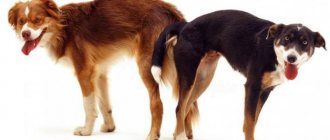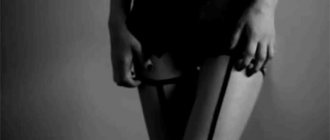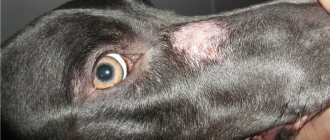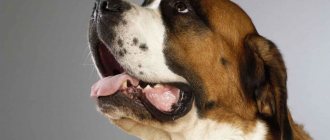Dog breeding is a complex process that typically begins with courtship, where the male and female give signals to let the other know that they are ready to mate. After completing the intimate process, you can often notice that dogs cannot separate, a so-called dog knot is formed. It is at this moment that we ask ourselves what to do at this moment, and how to untie this knot, and is it worth doing it at all?
As we say, this is a normal phase that should play a role in the reproductive success of the species. Therefore, in principle, we do not need to interfere. But, if this connection lasts longer, it may indicate a problem.
Mating dogs
We can define mating as the strong physical connection that is established between the dog and the bitch during mating. When the male's penis manages to enter the female's reproductive system, the bulb, which is located at its base, enlarges.
This cannot be achieved if the bulb swells before the act, since in this case it is not possible to insert the entire limb. This bulb is the so-called capitol bulb. This is the structure of erectile tissue. When it swells during reproduction, it is secured in the female reproductive system by the powerful constrictor muscles of the bitch's vulva, thus forming a canine knot .
The exact function of the clutch is not yet clear, but it is believed to stimulate ejaculation and hold the male penis until the dog is done. Although it has been proven that its duration does not affect the likelihood of fertilization, nor the number of puppies conceived.
© shutterstock
Castle phenomenon
Your dog's eyes are watering: why and what to do
The purpose of an animal's existence is to give birth. Dogs do not mate for the sake of pleasure - a natural physiological process has the ultimate goal of prolongation of the species. Crossing and sticking together is a guarantee of fertilization and a successful outcome of intercourse.
Important! Dogs stuck together are pitiful and helpless. They are dependent on each other and vulnerable.
At this time, a serious process is underway in the female’s body - sperm tend to the uterus and end up deep in the womb. The risk of loss of material is eliminated - the female has every chance of becoming pregnant. Another important point is that when the lovers open up, the weakened partner will not have the strength for another contender. “Love Lock” is insurance for a male dog to conceive puppies from him.
This behavior and physiology is characteristic of many school animals. The pack is divided into alpha males and weak, unworthy competitors. Strong animals strive to be the first to cover the female. The “lock” phenomenon is observed in the closest relatives of dogs - wolves, as well as foxes and hyenas.
Reproductive system of a male dog
To better understand why dogs engage in mating (canine knotting), it is important to briefly review the anatomy of both the male and female reproductive systems. Thus, the internal and external apparatus of a dog consists of the following parts :
- Scrotum . A sac that is responsible for protecting and supporting the dog's testicles at the appropriate temperature. In other words, this is the visible part of these glands.
- Testicles . Located inside the scrotum, they function in the production and maturation of sperm and male hormones such as testosterone. They are ovular in shape, located horizontally and, as a rule, symmetrical.
- Epididymis . Located in both testicles, they are the tubes responsible for storing and transporting sperm into the vas deferens. These tubes consist of a head, body and tail.
- Vas deferens . It begins in the tail of the epididymis and serves the function of transporting sperm to the prostate.
- Prostate . The gland that surrounds the neck of the bladder and the beginning of the urethra, and the size of which is not the same in all breeds, varying significantly from one to another. Its function is to produce a substance called prostatic fluid or seminal plasma to facilitate the transport of sperm and nourish it.
- Urethra . This tube is not only designed to carry urine from the dog's bladder, it is also part of the canine reproductive system, transporting sperm and prostate fluid for eventual ejaculation.
- Forearms . It matches the skin that covers the penis to protect and lubricate it. This second function of the foreskin is related to its ability to produce for this purpose a green liquid called esmegna.
- Pene . Normally it is located inside the foreskin. When the dog becomes aroused, an erection begins and, consequently, the appearance of the penis outwards. It is formed by the bone of the penis, which allows penetration, and the bulb of the penis, the ventral philtrum, which provides the so-called “canine knot”.
© shutterstock
What is the role of bonding for the female
Of course, the main goal of a love union is fertilization. As stated earlier, tail is a physiological process that nature has endowed with all breeds of dogs. It guarantees the appearance of offspring and prevents the female from being impregnated by another male.
Recommendations for novice dog breeders: do not disturb lovers when they are in a love castle. You can only lightly hold the mongrel so that it does not make sudden movements.
There are a number of reasons why mating is not possible:
- inexperience of partners;
- health problems;
- very young female;
- wrong time for mating.
The most favorable period for conception is considered to be 10-14 days of estrus.
Reproductive system of bitches
Like the male apparatus, the female reproductive system is made up of internal and external organs, some of which are responsible for keeping dogs in the castle after bonding. Below we briefly explain the function of each of them :
- Ovaries . Oval in shape, they perform the same function as the testicles in male dogs, producing eggs and female hormones such as estrogens. As with the male prostate, the size of the ovaries can vary depending on the breed.
- Oviducts . Tubes located in each of the ovaries and the function of which is to transfer eggs to the uterine horn.
- Uterine horn . Also known as the "horns of the uterus", these are the two tubes that carry eggs to the body of the uterus if they have been fertilized by sperm.
- Uterus . This is where zygotes nest to become embryos, fetuses, and subsequently puppies.
- Vagina . It should not be confused with the vulva because the vagina is an internal organ and the vulva is an external organ. In the female it is located between the cervix and the vaginal vestibule and is the place where sexual intercourse occurs.
- Vaginal vestibule . Located between the vagina and vulva, it allows penetration during mating.
- Clitoris . The function of this organ is to provide sexual satisfaction or stimulation to the bitch.
- Vulva . As we already said, this is the external genital organ of the female dog, and it changes in size during the period of heat.
Should I intervene?
Not all breeders know what to do in a dog breeding situation. Should animals be posted? Dog handlers and veterinarians say a categorical “no.” Experienced breeders continue to observe and control the process.
Even if the knot in dogs does not weaken for more than half an hour, you cannot apply physical force to the couple. You need to help the female if she breaks out of the “lock”. The zealous “bride” is calmed down. Sometimes the loin is held to direct the flow of sperm to the uterus. This is necessary when the female is smaller than her lover. They also help a male dog if he is unable to stand with his back to his partner after ejaculation. The dogs are not allowed to twitch.
Important! Animals are not forcibly separated, even if mating is not planned. This is fraught with injury and loss of animal health.
Young ladies get scared, the spasm can intensify to unbearable pain. In the future, they are afraid of partners and intercourse. Sexual intercourse can take even longer.
During intercourse, owners create a calm environment for the dogs. Before mating, the female is fed moderately; it is better not to feed the male at all. The couple is given the opportunity to walk around and run around. The process is best done in the evening or early in the morning. The male feels more confident in his own territory, so the “brides” are brought to his home. It is better if the sacrament of conception occurs in silence. They watch him from the side, not trying to separate the couple.
The first mating is often carried out with a muzzle.
The first mating of a young bitch is especially important. She can be aggressive. Often the act is carried out wearing muzzles. The suitable age for dogs is 2-2.5 years. Matings earlier than this period lead to unhealthy litters, and the physical condition of the parents is also at risk. Bitches are bred after the third heat.
The best time for pets to crossbreed is late autumn and winter. Puppies are born healthier. The hormonal surge during early mating slows down the growth of dogs. The timing of puberty is individual and depends on the size of the individual, breed, and psychological state.
Important! If mating does not occur during intercourse, a repeat control mating is carried out after 2-3 days while the bitch is in heat.
How long does mating last in dogs?
It is believed that for the coupling to be effective in its function of ensuring that sperm enters the bitch's reproductive system, it must last for at least two to three minutes . But very often this process takes from 10 to 40 minutes.
Given this data, the connection will be considered redundant as long as the duration exceeds one hour . In these cases, a physical problem may arise that prevents the couple from divorcing, and this is the doggy knot.
Hormonal imbalance
Often the cause of sexual hyperactivity is the body's excessive or insufficient production of one or another hormone. You can talk for a long time about the influence of hormones on the behavior of male dogs, but such an educational program will be of little help to the average person. But who can help is a veterinarian. If, despite all efforts to re-educate the fidget, a male dog marks at home, behaves aggressively towards other animals, loses appetite and peace when a girl is in the neighborhood - take a test to determine the level of hormones in the blood. Dysfunction of the pituitary gland, adrenal glands, thyroid, pancreas, gonads and other glands is not only behavioral problems, but also a serious threat to the dog’s health. It may be necessary to castrate a male dog - do not refuse the operation only for moral and ethical reasons. When a veterinarian recommends castration, it is no longer about your views on the issue, but about the duration and quality of life of a living creature.
Why does dog knot happen?
Once penetration has occurred, the cable tends to "rush" out, remaining attached to the bitch and causing the owners of both animals to wonder why the dogs got stuck during mating (formed a doggy knot) and how to separate them. This is because dog ejaculation occurs in three phases or parts:
- Urethral fraction . This is done when penetration is initiated and in it the dog releases the first fluid completely free of semen.
- Sperm fraction . After the first ejaculation, the animal ends the erection and begins to emit a second ejaculation, this time with sperm. During this process, the size of the penile bulb increases due to venous compression of the penis and, as a result, blood concentration. At this point the cable often tries to come out, so they stick together when mating.
- Prostate fraction . Despite the fact that the cable has already finished, copulation is not yet finished, since after that the so-called “buttoning” occurs due to the release of the third ejaculation with a significantly smaller number of sperm than in the previous one. Once the bulb relaxes and returns to normal, the dogs will separate .
In general, intercourse can last anywhere from 20 to 60 minutes, with 30 being the usual average.
Thus, we realized that the reason that answers the question of why dogs stick together during mating is the expansion of the penis bulb. The size it reaches, it cannot pass through the vaginal vestibule, which is closed precisely in order to guarantee this fact and avoid damage to the female.
© shutterstock
LiveInternetLiveInternet
As children, we all watched with joy how, after certain processes, two dogs could not separate from each other for a long time. Someone even tried to “help” with the help of a ball, a leg and a targeted blow, although the dogs did not need this, since this is inherent in their nature. For people, in terms of separation, everything is completely different. That is, we can do this at any time, even without the help of doctors. Now imagine a situation (I wouldn’t wish a real-life case on anyone) when suddenly you and your partner are stuck together. By “stuck together” I mean that it is impossible to pull the penis out of the vagina (it seems to be stuck there). What will you do? I certainly doubt that anyone has ever thought about such a problem, but if this happens, there will be no time for the smiles that may now appear on your faces. You can, of course, call an ambulance, or you can try what they will do to you in the hospital. I will try to describe the action from the words that came to me. Everything is very simple. In order to “unstick” in the hospital, both partners are simultaneously inserted into the anus with a finger. Thus, certain muscles contract and certain muscles unclench. If you and your partner can perform such a circus act, then there will be no need to call the ambulance. Good luck and may fate protect you from such situations.
What should I do, should I disconnect?
If you understand what is happening on the physical level, I think it will be easy for you to understand that we do not need to separate the dogs by force, moreover, if we do this, we can cause serious injury to the genitals of both. Even if it is an unwanted mating, the dogs should be allowed to finish and then contact a veterinarian. So keep these tips in mind :
- Keep calm. If dogs lose their perspective, nervous activity will only increase their stress. The result can be more movement and, as a result, more injuries.
- Don't pull either the male or the female.
- Don't water them.
Helminthiasis
If the owner does not regularly treat the pet for helminths, parasites can settle in the intestines. When there is a large accumulation of worms, they can clog the intestines and come out through the anus, causing irritation of the anus. The dog scratches it, crawling with its heel on the floor or ground.
Infection with worms can be suspected by weight loss, alternating constipation and diarrhea, deterioration in coat quality and the presence of blood in the stool. Sometimes worms can be seen in feces.
Important!
To eliminate parasites, anthelmintic treatment should be carried out at least once every three months.
Separating two dogs in a hitch
Firstly, you should only separate a dog's knot if they have been together for more than an hour. Less time is considered normal adhesion and therefore intervention never occurs. It is normal for a dog to moan, wail, or grumble during mating. This reaction does not require separation.
The separation can be accomplished with a relatively simple maneuver. But if you're very nervous, you don't seem able to do it, or you've tried without success, call your veterinarian. Never do this by force as you may harm the dogs or even get bitten.
Advice for dog lovers
The process of breeding dogs requires complete control, because anything can happen between four-legged “lovers”. It is always safer for the veterinarian to be in touch if he was not present during the mating.
If you do not want your pet to reproduce, you still should not try to separate her from the male during an accidental or planned mating. It’s too late to correct the situation once a fixation has occurred—you’ll simply harm the animals.
It is better to untie beginning “brides” and “grooms” by the age of two. Premature matings do not bode well. An organism that has not reached sexual maturity is susceptible to physical disorders and is unable to produce healthy offspring. Veterinarians advise breeding in winter. This way there is a greater chance of getting a full litter.
Important nuances of the first mating
Sometimes dogs are mated without gluing, as they say. But such mating is considered unsuccessful.
The dog knot fails for the following reasons:
- mating of young and inexperienced dogs
- wrong mating time
- Perhaps the animals have some abnormalities.
The successful mating time depends on the female's cycle. The most suitable period is considered to be after the third heat has begun. For example, if the first two heats lasted from 26 to 28 days, then days from 14 to 18 are optimal for mating for the third heat.
In order to get 100% results, it is necessary to perform pairing 2-3 times within the specified period of time.
For successful mating, location is also important. Mating is best done in the male’s habitat and without outside dogs. Since the female and male can become stressed when they are in the territory of other dogs.
The first mating experience is very stressful for dogs. It is important to understand that bonding can occur not only due to fertilization, but also due to the female’s fear. If she is afraid and is being held forcibly, then a canine knot will occur, but fertilization will not occur. Dogs will experience severe pain. This may cause fear before the next mating. Therefore, a correctly structured first mating process is very important.











